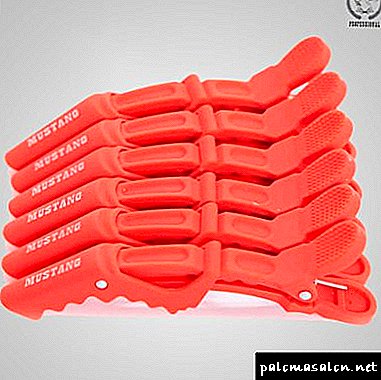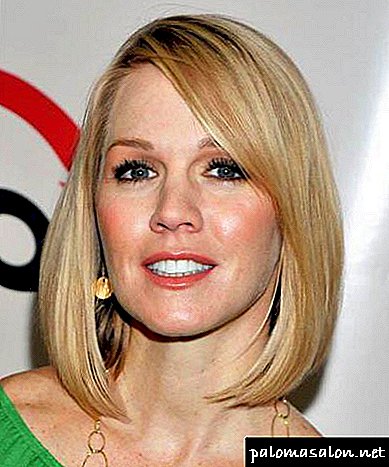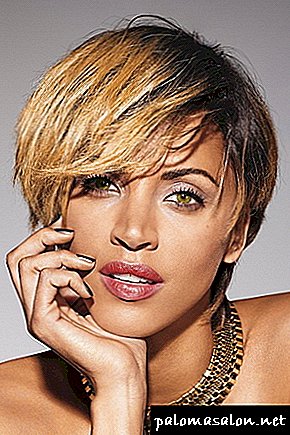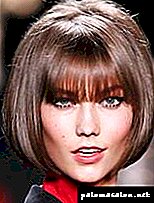Hairdressing, like any other creative activity, requires special tools, without which it is impossible to organize the work of a master. These are various combs, several types of scissors and, of course, many-sided clamps. The latest accessory tool should be considered in more detail.

What is hairdressing hair clips for?
Hairdressing clips for hair - this is one of the essential tools, without which it is impossible to perform high-quality, haircut, curl curls and carry out a number of other procedures, including dyeing, building up strands. Due to constant use, such devices should be distinguished by increased strength, easy fixation on the hair and trouble-free removal.
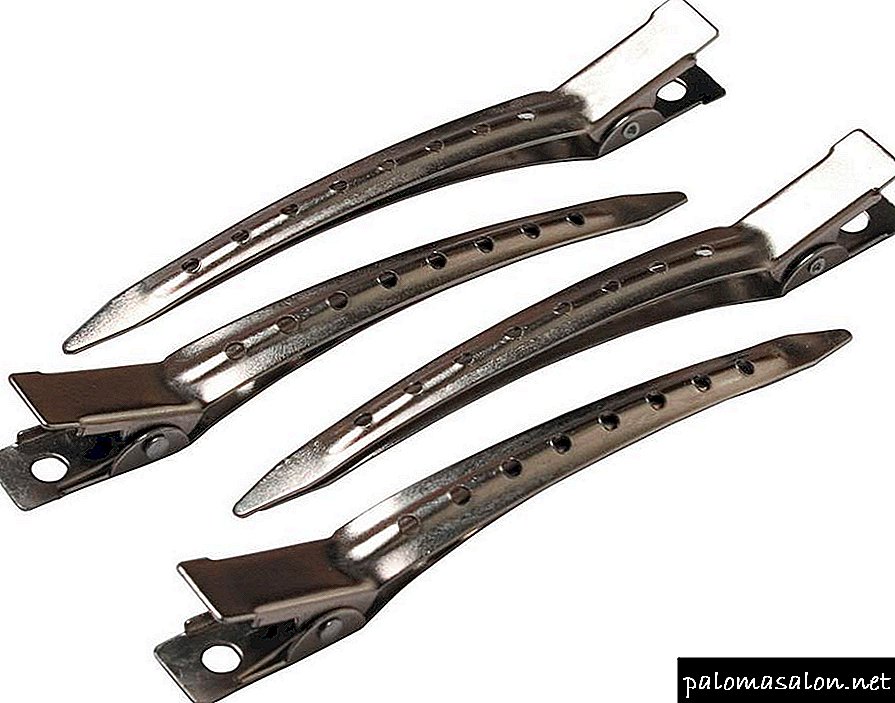
The main element becomes a rigid retainer, due to which the strands are securely supported in the desired position, without complicating the work.
Types of fixtures
According to the material, hair styling clips are divided into metal, aluminum, plastic and carbon. Depending on the design and functional features, such devices are represented by the following main types:
- Duck. Cranes and crocodiles are a variation of this option.
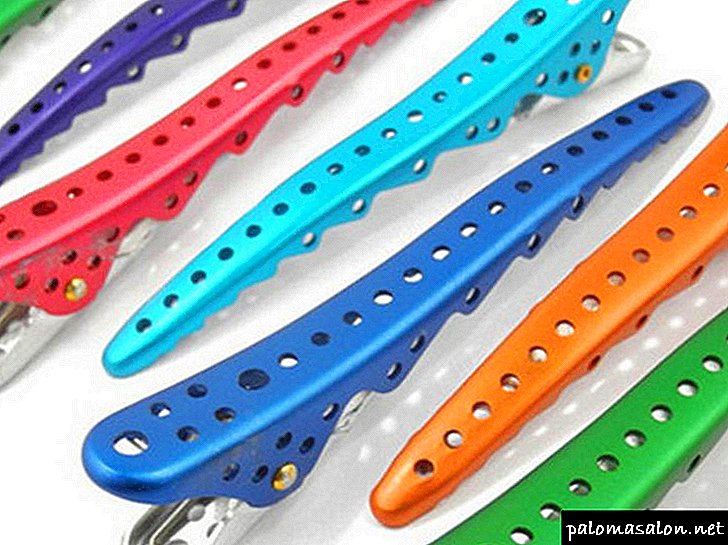
Separately, it is worth noting a special crab for hair curlers. This hairdressing tool is designed to hold the strands on plastic curlers with a width of about 60 mm. Also, today professional masters widely use reinforced claws, the feature of which lies in the original design, which is characterized by the addition of a profile with a curved element with large teeth, which promote tight adhesion to hair.
For the most comfortable work at hand should be all kinds of clamps.

Where can I buy and the average price
The determining factor for the cost becomes the type of adaptation. So, hairdressing hair clips in the form of reinforced duck models can be purchased in online stores at a price within 350 rubles for a set of 4 positions, and multi-colored crocodile clips, presented in several sizes, are offered approximately 500-600 rubles per pair. . Metal fixtures can be purchased in the form of a set of 10 units at a cost of about 450 rubles, and carbon crocodile clips - a set of 9 pieces worth 230-250 rubles.
Miniature plastic butterflies are sold immediately for 12 pieces in a set, which costs about 130 rubles, if you want to buy beautiful color accessories for haircuts and styling, you can count on the same price.
As you can see, there are quite a few options for hair clips. Choosing a suitable option, you can stop not only on practical, but also beautiful hairdressing tools, taking haircuts and styling to a new level, because aesthetics is one of the success factors.
What are hairdressing clips?
It should begin with the fact that the clamps on the principle of capture are divided into two large types - the type of "duck" and the type of "crab". "Crab" with their narrow grip and long teeth are more often used for the daily holding of strands, more often they are decorative. A "duck" with two long plates, fastened at one end, usually rule the ball at the hairdresser - although decorative too.
"Ducks", in turn, are divided into several species.
Classic "ducks" - universal hair salon clip
These clips are the most versatile. We at Mustang Professional believe that such clips are best made of carbon fiber - a lightweight, reliable material that does not create problems even in aggressive chemical environments during chemical dyeing and painting.
It is this material that makes them completely and absolutely universal. Actually, that's why we carry them out of carbon.
You can order a set of such clips in black, red or white.
Types and classification of accessories
How diverse the world is in its beauty, how many colors modern shops offer us, including shops with various hair accessories!
Despite the variety of materials, they all converge to a single classification and are divided into several types.
These hairpins differ not only in their appearance, but also because they are unusually practical.
They are made of different materials, they can be decorated:
- rhinestones,
- flowers,
- beads,
- or other items.
Note. Small crabs are used to decorate hair outlines and create a festive style.

Large crabs extremely conveniently and quickly fix hair.
Most often, these hairpins are divided into two types:
If the former are used to decorate the hairstyle, the latter help to pick up the hair or divide it into several parts. Such accessories are very convenient when creating a complex hairstyle.
Classic clamps
Usually they are a great accessory that can take and hold even lush hair.

Most often they are used to create tails and other simple hairstyles.
If before they were made only of plastic, now you can see a lot of options, made of metal or aluminum.
Note!
In addition to these options, professional or work clips are also distinguished, they usually help in working with hair and do not carry a decorative function.
Where professional clips are used
They say that a complete image can not be obtained without well-groomed hair, and therefore in the struggle for perfect appearance from time to time all girls need hairdressing services.

In order for your care to be complete and professional, many use aids.
One of these things is considered to be clips and hairpins for hairstyles, which are used during styling, drying and other operations.
They are mainly used to fix the hair, and therefore are distinguished by their density and fixation.
Unlike decorative hairpins, professional devices have:
Note!
In order for the hair not to dry out and retain its luster, it is customary to use cold air, in this case all sizes of this accessory will fit (small, medium, large).
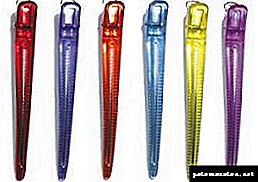
Most often, these hairpins are used for:
- Hair styling after curlers.
- Dividing the hair into separate sections and their fixation.
- "Capture" the edges of the hairstyle.
- Long curling hair for fixing.
There are several types of hairpins, which differ in appearance and method of fixation.
Modern "crocodiles" - the most reliable hair clips
Modern "crocodiles" are such grown up "ducks" with grown teeth. In the hands of a skilled hairdresser, they do not bite with these teeth, but hold their hair as securely as even the most professional "ducks" would never have succeeded. For this, and loved by the masters.
These clips are available in black and red.
Hidden-rubber clips - the most careful hairdressing clips
Option with hidden rubber band - the most tolerant and humane. No, theoretically, if you want to by all means tear out the strand of the client with such a clip - you can probably do it. But this will have to try hard.
To pull out the hair with such a clip is really difficult. Therefore, beginners often prefer to play it safe and choose them.
Mustang releases such clips in black, pink and white versions.
How to order professional hairdressing clips?
There is nothing easier. In our catalog, you can choose any set, add it with any other set - or even professional scissors in general - and order it with delivery to any city in Russia.
We have been studying the real needs of hairdressers for a long time in order to create such tools that would be ideal for them. Apparently, we did it. With the tools of Mustang Professional, your work will be easier and more enjoyable than without them.
Types and classification of accessories
How diverse the world is in its own beauty, how many colors modern shops offer us, including shops with different hair accessories!
Despite the abundance of materials, they all converge to a single systematization and are divided into a number of species.
These hairpins differ not only in their own appearance, but also because they are extremely comfortable.
They are made of various materials, they can be decorated:
- rhinestones,
- flowers,
- beads,
- or other items.
Note. Small crabs are used to decorate hair from hair and create a solemn style.

Huge crabs only comfortably and rapidly fix the hair.
In most cases, these hairpins are divided into two types:
If the first ones are used to decorate hair styles, the second ones help to pick up hair or divide it into several parts. Such devices are very comfortable when developing a complex hairstyle.
Traditional clamps
Usually they are a big device that can take and hold even lush hair.

In most cases, they are used to create tails and other regular hairstyles.
If previously they were made only from plastic, at the moment you can see a huge number of options made of metal or aluminum.
Pay attention!
Apart from these options, professional or working clips are also distinguished, they usually help in working with hair and do not carry a decorative function within themselves.
Where are used professional clips
They say that it’s impossible to get a finished image without well-groomed hair, and therefore, in the struggle for flawless appearance, at times all girls need hairdressing services.

In order for your care to be complete and professional, many use aids.
One of the similar things is considered to be clips and hairpins for hairstyles, which are used for styling, drying and other operations.
In the main, they are used in order to fix the hair, and therefore differ in their own density and fixation.
Unlike decorative hairpins, professional devices have:
Pay attention!
In order for the hair not to dry out and retain its own radiance, it is customary to use cool air, in which case all the sizes of this device (small, medium, huge) are suitable.

In most cases, these hairpins are used for:
- Hair styling after curlers.
- Dividing the hair into separate sections and their fixation.
- "Capture" the edges of the hairstyle.
- Long curling hair for fixing.
There are a number of types of hairpins, which differ in type and method of fixation.
Types of working parts
Clamp-duck has a long body and small teeth, there are several varieties:
Clamp-crab - differs in a small body, but with large and rigid teeth. Has a variety in the form of a butterfly clamp.
Pay attention!
The cost of these accessories depends not only on their type, but also on the material from which it is made.
So, distinguish clips:
Thanks to their differences, your master will easily be able to adjust the density and strength of fixing your hair.
Homemade barrettes
If, bypassing all the shops and break the entire web, you have not found a suitable option for the hairpin, you can make such a device at home.

Set to create a decorative clip.
In the main, they all differ in that they are quite ordinary to make. Let's see that we will certainly come in handy when developing such accessories with your own hands.
So, for the production of clips with your own hands you will need:
- Clamping mechanism - You can purchase this item in special stores for needlework, you can also use a clip from an old hair clip, if you have one.
- Bonding material - it can be PVA glue, thermogun or ordinary threads. All this depends on the material with which you work.
- Main material - depending on the appearance and purpose of the barrette, it could be: satin fabric, a ribbon of different material, lace, suede, or any other material that can give a hint to your imagination.
- Auxiliary material - for decoration of the finished hairpin, you can use buttons, beads, glitters, lace, thin ribbons and other objects.
Small annotation on making:
- At first, you will make any decoration, such as a bow, a flower or an animal.
- And later attach your product to the clamping mechanism with glue or threads.

It is enough only to fasten a couple of objects - and the decorative clip is ready.
Types of work items
Clamp-duck has a long body and small teeth, there are several varieties:
Clamp-crab - different small body, but large and rigid teeth. Has a variety in the form of a butterfly clamp.
Note!
The price of these accessories depends not only on their type, but also on the material from which it is made.
So, distinguish clips:
Thanks to their differences, your master can easily adjust the density and strength of fixation of your hair.
Making barrettes at home
If you go around all the shops and break the whole Internet and you haven’t found a suitable hairpin for yourself, then you can create such an accessory at home.

Set to create a decorative clip.
Basically, they differ in that they are quite simple to manufacture. Let's see what we definitely need when creating such an accessory with your own hands.
So, for the manufacture of clamps do it yourself, you will need:
- Clamping mechanism - You can buy this item in special shops for needlework, you can also use a clip from an old hair clip, if you have one.
- Bonding material - it can be PVA glue, heat gun, or regular threads. It all depends on the material you work with.
- Main material - depending on the appearance and purpose of the barrette, it can be: satin fabric, a ribbon of various materials, lace, suede or any other material that your fantasy tells.
- Auxiliary material - you can use buttons, beads, glitters, lace, thin ribbons and other items to decorate the finished hairpin.
Small instructions for making:
- First you will make any decoration, such as a bow, a flower or an animal.
- And then attach your product to the clamping mechanism with glue or thread.

It is enough to fasten a couple of objects - and the decorative clip is ready
What are hair clips for?
The main purpose of decorative hair clips is to decorate hairstyles, with which they successfully cope. Classic hairpins of this type are usually quite large in size and can hold even the thickest and most luxurious hair. Once they were made mostly of plastic. Now you can find many different options, made of metal, aluminum or wood. Large hair clips are used for the beam, tail, shell and other simple hairstyles, with which the hairpin gives a special charm.
Small hair clips fix bangs, use for the hair "half up, half down" and the like, where you need to collect one or more small strands of hair. These hairpins can be multi-colored, with bows, flowers, ribbons, rhinestones, pebbles and other decorative elements.
A distinctive feature of professional clips is a more rigid fixation and lack of decoration.Thanks to modern materials from which these hairpins are made, they can be used even when dyeing hair using any oxidizing agents. Also, hairdressers use clips for cutting, curling, to capture the edges of the waves, when splitting hair into strands and further fixing them in a hairstyle, when styling strands into waves after curlers. Modern hairpins are designed in such a way that the master can independently control the stiffness of the gripping strands and the degree of its fixation on the hair.
Needlewomen can easily create an original and unique hairpin-clip independently. To do this, you will need a base, which you can buy in the store for hand made, elements for decoration, bought or made by yourself, and a little imagination. Create a hairpin in your favorite style, and choose the color corresponding to the color type of the exterior. Your hairstyle with such an accessory will surely attract admiring glances of passersby. Hair accessories do not happen much.
Re: Hair Clips
I also met such clamps and how do they hold, tightly? I have others, like "butterflies", not very pleased with them. Now I want to take for myself, aluminum)
3 Reply from Angelina Ledovskaya 05/11/2010 20:39:43
- Rating: 14
- Registered: 27.03.2010
- Messages 64
- Thanked Total: 2
Re: Hair Clips
I have black carbon WELLA, good for short hair. Form, as in the photo above! I also want something for the long to find beautiful.
Types of hairdressing tools
Since our page is addressed to those who are at the beginning of the path of mastering the skills and habits of hairdressing, we consider it worth mentioning the hairdressing tools.
Like any kind of human activity, hairdressing does not stand still. In connection with the development of hairdressing technologies, the tools used by the hairdresser are constantly being improved, as well as new ones. First you need to have a minimum set of tools that will get you started. So, we list them:
Combs
We need three types of combs, each of which performs certain operations:
 Comb with a thin long handle and fairly frequent teeth (it is called the "tail"). This is the main working comb. It is convenient to separate the strands of hair. It is plastic and metal. It is better to have both. It is good to use a metal comb for a pile, and when performing a perm and dyeing the hair it cannot be used, since the metal will react with the preparations for the perm and chemical dyes. Performing haircuts, you can use both plastic and metal.
Comb with a thin long handle and fairly frequent teeth (it is called the "tail"). This is the main working comb. It is convenient to separate the strands of hair. It is plastic and metal. It is better to have both. It is good to use a metal comb for a pile, and when performing a perm and dyeing the hair it cannot be used, since the metal will react with the preparations for the perm and chemical dyes. Performing haircuts, you can use both plastic and metal.
Comb for shading. Her teeth have unequal pitch. On one half, the teeth are sparse, and on the other, they are quite frequent. It should be about 20 cm long, with a narrow canvas and have a narrow pick.
Comb with long sparse teeth - for combing long hair or hair with broken structure. It is also used for combing hair after perm.
Brushes
Brashing - round brush. It is used when styling with a hair dryer to raise the hair at the root and twist the strands. It happens in different diameters.
Skeletal brush - flat or curved brush with slots. It is used when laying by the hair dryer. It is convenient to raise the strands of hair at the root. Thanks to the slots, hot air passes through the brush.
Massage brush - a semicircular brush that gives hair fluffiness. It is better to use a brush with metal teeth, because it is easier to disinfect. The rubber base on which the teeth are fitted should be soft and the ends of the teeth smoothly processed.
For individual use are good brushes with wooden teeth (provided good tooth processing), as well as brushes made of natural bristles.
Scissors
Conventional hairdressing scissors.
They should be made of high quality steel and very sharply sharpened. The arrangement of the fingers in their rings is as follows: the thumb is in one ring, the ring finger in the other, the ring may have a reinforcing lever on which the little finger is placed.
Thinning scissors.
Such scissors have teeth on their cloth, due to which the length of hair at the ends becomes different. The height of thinning depends on the size of the thinning tooth of the scissors. It is better to use double-ended thinning scissors.
Tip: when choosing scissors you need to make sure that the shears of the scissors fit snugly together. To do this, look at the light, the gap should be absent. Use scissors, their stroke should not be too tight or too loose. Scissors are best kept in a case.
Clamps and ducks
There are plastic and metal. They pinch hair that interferes with haircut.
 Hair dryer
Hair dryer
In the work it is better to use a hair dryer, in the form of a gun. Hairdryer is used to make hair look luxuriant. When using a hair dryer should not dry your hair with a very hot stream of air, as they begin to split.
Curling Tools
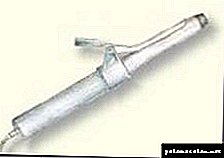 Smoother with side grip. Used for curling curls and hair styling of any length. It happens different diameters.
Smoother with side grip. Used for curling curls and hair styling of any length. It happens different diameters.
 Curling pad with retractable plastic spikes. Used to create curvy curls.
Curling pad with retractable plastic spikes. Used to create curvy curls.
Tip: Frequent use of curling has a negative effect on the health of the hair. To reduce the damage to the hair, you can moisten it with hair lotion, foam or mousse before winding it up. The same means are locking. You can not use curling for several days after perm, as this will lead to severe damage to the hair.
Thinning razor.
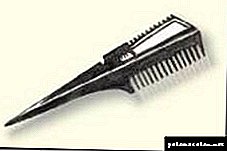 Thinning razor can perform haircuts, characterized by smooth lines and completeness of forms. And also along with thinning shears it is used for thinning.
Thinning razor can perform haircuts, characterized by smooth lines and completeness of forms. And also along with thinning shears it is used for thinning.
Sprayer.
Designed for wetting hair during the haircut.
Hair clipper
 Replaceable nozzles are attached to it, with the help of which the hair is cut at different lengths. There are cars available without attachments, but it will be quite difficult for a beginner to use them.
Replaceable nozzles are attached to it, with the help of which the hair is cut at different lengths. There are cars available without attachments, but it will be quite difficult for a beginner to use them.
Tool processing
Tools need to be processed after each haircut. Plastic tools are treated with a solution of chloramine B (one teaspoon of chloramine B per 1 liter of water), immersing them in the solution for 15-20 minutes. The desktop is wiped with the same solution. Metal tools are best treated with alcohol.
Hairstyle tools
Good brushes make brushing not only more exciting, but also easier. Brushes, combs and hairpins - the basic tools for combing. The following is a guide to help you choose from the variety of tools offered the most appropriate.
BRUSHES
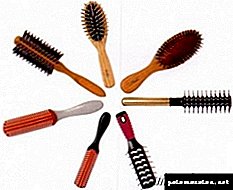 Brushes are made from bristles (sometimes called feathers or pins), which can be natural pork, plastic, nylon or metal. The bristles are inserted into the wooden, plastic or molded rubber base in rows or tufts. This allows you to collect falling hair in the gaps and not interfere with the action of the bristles. The resolution of the bristles has its own meaning: the wider the gaps between the rows, the easier the brush passes through the hair.
Brushes are made from bristles (sometimes called feathers or pins), which can be natural pork, plastic, nylon or metal. The bristles are inserted into the wooden, plastic or molded rubber base in rows or tufts. This allows you to collect falling hair in the gaps and not interfere with the action of the bristles. The resolution of the bristles has its own meaning: the wider the gaps between the rows, the easier the brush passes through the hair.
Scratching rules
Brushes help to untangle hair and smooth them. Brush movements from the roots to the ends remove dead skin cells and dirt, keep the cuticle in a smoothed state, when it reflects light better. Brushing can also stimulate blood circulation in the follicles, promoting healthy hair growth.
Natural bristles
Natural bristles consist of keratin (the same substance as the hair) and therefore creates less friction and less damage to the hair. It is good for care and giving gloss and does not allow static electricity on the hair. However, it does not penetrate the wet or thick hair, in addition, for thin hair, you must use a brush with softer bristles. On top of that, sharp ends can scratch the skin.
SOME FACTS
In the 17th century, it was believed that combing hair with a brush deprives a person of the ability to enchant, women were advised not to comb their hair in the evening, as this could cause a headache the next day.
Hair brushes made of pig bristles or hedgehogs needles, appeared for the first time at the end of the Middle Ages. With the invention of nylon in 1930, the manufacture of brushes has become widespread, and now their range is very wide and each is designed for a special purpose.
Plastic, nylon and metal brushes
All these brushes are heat-resistant and easy to clean, they are good to use when drying with a hairdryer. They come in various shapes. Brushes with a pillow well spring, passing through the hair, prevent jerks and help to unravel the hair. They also do not electrify hair.
The worst thing is that the ends can be rough, so try to choose a brush with rounded ends.
THE WASHING UP
All brushes should be cleaned of lost hair and washed with warm soapy water, and then rinsed thoroughly. Brushes made of natural bristles should be placed with bristles down and left in the air until dry. If you use a pneumatic brush with a rubber pad, close the air hole with a match before washing the brush.
BRUSH TYPES
Round, or radial, brushes come in different sizes and round or semi-circular in shape. These brushes or nylon bristles with a soft rubber gasket (to complete the hair), or metal pins (for styling). They are used for styling and caring for natural curly and wavy hair, are applied after permanent and are ideal for drying with a hair dryer. The diameter of the brush determines the volume and mobility in the hair as well as the size of the curlers.
Flat or semicircular brushes are ideal for all operations with wet and dry hair and for drying with a hair dryer. Usually they are made of nylon with a rubber base. In some of them, the base slides on a plastic molded handle. The rubber base can be removed for washing or for the necessary replacement of bristles.
Pneumatic brushes have a convex rubber base with bristles assembled in bunches. Bristles can be plastic, natural or mixed.
The blower brushes have a hollow center, which allows air to be blown through them. Special bristle or pin-shaped elements are designed to lift and unravel even wet hair. The blowing and tunnel brush attachments allow air to circulate freely through the brushes and hair, so that the hair dries faster.
TIPS
- Replace brushes and combs with damaged bristles or broken teeth, sharp ends can damage the skin,
- Let your combs and brushes be just for you, never lend them to other people.
 DESIGN
DESIGN
Choose good quality combs with treated teeth. This means that each tooth is cut so that there are no sharp ends. Avoid cheap plastic hairbrushes, which are made by stamping and have a scar in the center of each tooth. They are sharp and. gradually tearing off the cuticle, cause damage to the hair.
For unraveling and combing hair, use a comb with rare teeth. Combs with a thin handle - for styling, afrorascic - for curly hair.
 STICKS AND CLAMPS
STICKS AND CLAMPS
These things are absolutely necessary for separating and fixing the hair when styling the hair and for lifting the hair. Most studs have blunt, smooth ends or with pads at the ends. Hairpins do not reflect light and hardly noticeable in the hair, most of them are made of metal or plastic. They are brown, black, gray, white, silver and straw color.
Studs- This hairpins are used to secure the curled curls. Hairpins fix curls, French folds and all hairstyles raised to the top. In North America, they are known as bobby-pins, in England they are Blendrights and Kirby. To avoid inconvenience, place the hairpins in your hair so that they rest on the skin with their flat side.
Stiff studs are made of hard metal and are wavy or straight. They are ideal for fastening curlers and raised hair.
Thin studs are used to maintain shape. They are very thin and are lost in the hair, so they are used to fix only small strands of hair. These studs are easy to hide, especially if they are matched in color. They are suitable for securing tips curls when making hairstyles more than tough studs that are noticeable.
Section clamps, fastened at one end, longer than the other clamps. They are more often used for fixing hair when working with another part or for fixing tips of curls. Twist-shaped twist studs are used to secure beams and French folds.
BIGUDI
Curlers differ in diameter, length and the material from which they are made. Smooth curlers, without thorns and brushes, give the smoothest curls, but they are harder to twist hair. Velcro curlers (hedgehogs) are a more popular option — a special locking option that does not need clamps.
TIPS
- The smaller the curlers, the smaller the curls.
- Stretch your hair when curling up on curlers.
- Try not to crush the ends of the hair.
BOOMERANGES
Boomerangs were invented by the type of hair curling on rags. Soft twisted boomerangs are made of flexible rubber, plastic or cotton and are one of the easiest ways to curl hair. Inside each boomerang is a soft wire that holds a shape. Waves or curls curled on boomerangs are soft and elastic, and this is an excellent curl for permanent or colored hair.
For winding strands of clean and dry hair, they pull, catching the end on a boomerang, which is previously moved apart. Rotate down to the hair roots and fold the boomerang to secure. Leave for 30–60 minutes without heating or for 10–15 minutes with heating. If you twist the strands with a braid before winding, you will get a more voluminous hairstyle
Curling irons and professional hair curlers
Curling irons and professional hair curling tongs are power tools designed to create the most fashionable and creative styling.
The most famous manufacturers of pleyos and tongs are the firms Gamma Piu, Ga. Ma., BaByliss, Velecta Paramount, Valera, TEK, Parlux, Tecnoelettra, Sibel and Wik.
All professional hair curlers and curling irons can be divided into three main groups: hair curling curlers, hair curlers with nozzles, and hair straighteners (Hair flat irons).
Curling irons for hair - represent a hollow metal core with a heating element installed inside. Outside mounted special spring-loaded clip for fixing hair. The configuration of such ployok is the most diverse: the classic round bar rods, single and double spiral curls, single and double triangular curls, double and triple curls with parallel rods, double curl rods with knitting needles.
Classic curling rods with a round rod come in with different cross-sectional diameters (from 10 to 36 mm). Their power reaches 125 watts. An example of such pleyok is a model of the company BaByliss (diameter 13, 16, 19, 25 and 32 mm.)
Unary and double triangular professional curling iron come in different sizes (from 10 to 20 mm). Their power - from 25 to 50 watts. An example of a single triangular curtain is a Ga model. Ma. To date, while only one company is engaged in the production of double triangular pleyok. This is the company Gamma Piu. This company has created Accademy Triangolo curling irons (10 and 20 mm). In these curling irons, not one triangular rod is heated, but also a concave rod for fixing the original “torn” curl.
Single and double spiral curls are also made of different diameters (from 10 to 18 mm). It depends on what “step” of the helix how steep the curl will be. The power of these ploek - from 25 to 50 watts.An example of a single spiral pleyok are models of firms Ga. Ma. (with a diameter of 16 and 18 mm.) and Tecnoelettra (with a diameter of 13 and 18 mm, art. 109 and 109.18). We know only one manufacturer of double spiral pleyok - the company Gamma Piu. This manufacturer has created Accademy Spirale curling irons (10, 12 and 16 mm in diameter), in which not only the spiral rod, but also the concave rod is heated to fix the curl.
Double and triple curling rods with parallel rods, as well as double curling rods with rods in the shape of knitting needles have a similar purpose: wrapping curls of different lengths in the form of “eight” and other types of creative styling. The power of such ploek - from 25 to 63 watts. Triple curling was created by BaByliss. As in the classic curling iron of the same manufacturer, it has 25 levels of heating for different hair types. Velecta Paramount (Ondul’hair model) is a manufacturer of knitting needles.
Curling hair dryers with a brush
Curling hair dryers with a brush combine the functions of a hair brush and a hair dryer. The power of such ploek - up to 1200 watts. Some curling irons of this group are supplied with a nozzle like a hair dryer (nozzle). As well as additional nozzles-brushes of the most different forms (up to 5 such nozzles can be included in one set). The most famous manufacturer of such pleyk is the company Wik.
The innovative development in this type of pleyok was Valera's curling iron dryer with an adjustable ionization system and with 3 nozzles included.
Nippers rectifiers for hair "Irons for hair"
The hair straightener is designed primarily for straightening curly hair. That is why they are also often called “hair irons”. The power of such forceps reaches 175 watts. The use of forceps, corrugation allows you to create on the hair a lot of patterns of different clarity and sharpness - they can be both smooth and chopped. The principle of action here is the same as that of the “hair irons”: a strand of hair is clamped between two plates, the working surface of which, however, is not smooth, but corrugated. The size and design of working plates, at the same time, can be very different: narrow, standard, wide, concave.
Scrollability and cord length
Scrollable cord is available in almost all models on the market pleyok. Now, when styling, you do not have to literally twist your arms to, for example, gently add hair volume. The cord length can reach 3 m. - which is important for working in the cabin.
Thermostat - this is a very important and necessary option of forceps. Automatic regulation of the heating level allows you to avoid injury to the hair - the master simply sets the temperature setting on the controller that is appropriate for this type of hair. The comb is supplied mainly with “irons” and curling flutes. It does not allow strands to "slide off" from the smooth surface of the curling, and when straightening the hair, it also combs them.
Nozzles Let's start with the fact that the nozzles may not be at all, as is the case with the classic curling irons, with some models of tongs-rectifiers and curling hair dryers. Usually, 3 corrugation nozzles or 3 nozzles with different patterns are attached to the rectifier curling iron. Thus, with the help of one curling it is possible to achieve completely different results. Another important characteristic of the forceps, greatly facilitating the work of the master, is the convenience of changing nozzles.
Cases where the entire hairstyle is done with the help of tongs, corrugation, are very rare. As a rule, corrugated strands are combined with straight lines, thus, emphasizing the originality of styling.
Working surface
In classic curls, this is the core on which the strand is wound; in curls, hair dryers is a comb; in rectifiers and rectifiers with nozzles (corrugation or patterns), this is, respectively, a straightening nozzle or a nozzle-corrugation (nozzle with patterns). The beauty of the resulting waves or patterns depends on the working surface. The working surface of most of the ploies is made of a metal alloy that withstands high heat. The smoothest surface is in the ploek, which use ceramic-ion technology.
Ceramic coating with crystal structure. Plates of a curling iron are covered with a ceramic layer with a crystal structure. It completely covers the microscopic pores of the metal. This allows the curling iron to better slide through the hair and protects the plates from chemical solutions and styling products. Due to the fact that in ploek with a working ceramic coating the working surface itself heats up instantly (this is due to the action of the ceramic thermocouple), the hair is exposed to a high temperature for only a short time, which is beneficial for them.
Ion technology. A feature of the piles in which this technology is applied is a special ionic coating of metal plates. In such hair curlers, negatively charged electrons, which have a huge energy potential, are emitted from the working plates, and water molecules do not evaporate due to the ionization process. Negatively charged particles penetrate into the hair structure, as a result, the hair becomes more elastic and soft, their natural moisture does not change, the hair is regenerated and rejuvenated, the hair scales adhere to each other more strongly, the natural shine of the hair is more pronounced.
Laser ionization system. This system is installed in the "Ga. Ma." not under the plates, but in a special compartment on the surface of the forceps. Thus, negatively charged electrons are emitted with laser precision between the working surfaces of the two plates.
Already several companies have produced rectifiers with ceramic, ion and ceramic-ion coating of various colors, sizes and design:
Velecta Paramount is a manufacturer of the narrowest TechniLiss forceps with rectifier with a ceramic-ion coating of purple color of 3 sizes: 12, 28 and 48 mm, and 25, 40 and 53 W respectively. Gamma Piu company produces the widest model range in the world of tongs and rectifiers of various sizes with ceramic, ion and ceramic-ion coating. There are models with and without comb, with and without thermostat, with a recess and with a straight surface, with a carbon body and a thermoplastic body. The color of the coating is mainly white. Firm "Ga. Ma." produces tongs-rectifiers with a ceramic heater, where the coating of the plates is ceramic with a crystalline structure, ceramic-ion and satin. Models come with or without a comb, with or without a thermostat. In addition, they can be narrow, standard size and with interchangeable nozzles. The color of the coating is mainly black. BaByliss manufactures ceramic straightening tongs, most often white, with different plate widths, with or without a comb, narrow for a straight and concave surface design, with and without a thermostat. Tecnoelettra has developed narrow tongs-rectifiers with a ceramic heater with a satin-coated and a yellow-colored ceramic coating.


